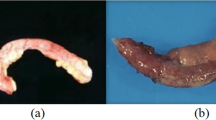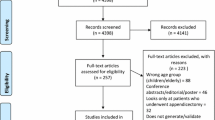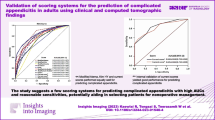Abstract
Background
Appendicitis is one of the most common surgically treated diseases in the world. CT scans are often over-utilized and ordered before a surgeon has evaluated the patient. Our aim was to develop a tool using machine learning (ML) algorithms that would help determine if there would be benefit in obtaining a CT scan prior to surgeon consultation.
Methods
Retrospective chart review of 100 randomly selected cases who underwent appendectomy and 100 randomly selected controls was completed. Variables included components of the patient’s history, laboratory values, CT readings, and pathology. Pathology was used as the gold standard for appendicitis diagnosis. All variables were then used to build the ML algorithms. Random Forest (RF), Support Vector Machine (SVM), and Bayesian Network Classifiers (BNC) models with and without CT scan results were trained and compared to CT scan results alone and the Alvarado score using area under the Receiver Operator Curve (ROC), sensitivity, and specificity measures as well as calibration indices from 500 bootstrapped samples.
Results
Among the cases that underwent appendectomy, 88% had pathology-confirmed appendicitis. All the ML algorithms had better sensitivity, specificity, and ROC than the Alvarado score. SVM with and without CT had the best indices and could predict if imaging would aid in appendicitis diagnosis.
Conclusion
This study demonstrated that SVM with and without CT results can be used for selective imaging in the diagnosis of appendicitis. This study serves as the initial step and proof-of-concept to externally validate these results with larger and more diverse patient population.


Similar content being viewed by others
References
Ferris M, Quan S, Kaplan BS, Molodecky N, Ball CG, Chernoff GW, et al. (2017) The Global Incidence of Appendicitis. Ann Surg [Internet]. 2017 Aug 1 [cited 2020 Aug 10]; 266(2):237–41. Available from: http://journals.lww.com/00000658-201708000-00008
Repplinger MD, Weber AC, Pickhardt PJ, Rajamanickam VP, Svenson JE, Ehlenbach WJ et al (2016) Trends in the use of medical imaging to diagnose appendicitis at an academic medical center. J Am Coll Radiol 13(9):1050–1056
Alvarado A (1986) A practical score for the early diagnosis of acute appendicitis. Ann Emerg Med [Internet]. 1986 May 1 [cited 2020 Sep 8]; 15(5):557–64. Available from: http://www.annemergmed.com/article/S0196064486809933/fulltext
McKay R, Shepherd J (2007) The use of the clinical scoring system by Alvarado in the decision to perform computed tomography for acute appendicitis in the ED. Am J Emerg Med [Internet]. 2007 Jun 1 [cited 2020 Sep 8]; 25(5):489–93. Available from: http://www.ajemjournal.com/article/S0735675706004153/fulltext
Coursey CA, Nelson RC, Patel MB, Cochran C, Dodd LG, DeLong DM, et al. (2010) Making the diagnosis of acute appendicitis: Do more preoperative CT scans mean fewer negative appendectomies? A 10-year study. Radiology [Internet]. 2010 Feb 7 [cited 2020 Aug 11]; 254(2):460–8. Available from: www.rsna.org/rsnarights.
Bax T, Macha M, Mayberry J (2019) The utility of CT scan for the diagnostic evaluation of acute abdominal pain. Am J Surg 217(5):959–966
Coleman JJ, Carr BW, Rogers T, Field MS, Zarzaur BL, Savage SA, et al. (2018) The Alvarado score should be used to reduce emergency department length of stay and radiation exposure in select patients with abdominal pain. J Trauma Acute Care Surg [Internet]. 2018 Jun 1 [cited 2020 Sep 8]; 84(6):946–50. Available from: http://journals.lww.com/01586154-201806000-00015
Prabhudesai SG, Gould S, Rekhraj S, Tekkis PP, Glazer G, Ziprin P (2008) Artificial neural networks: Useful aid in diagnosing acute appendicitis. World J Surg [Internet]. 2008 Feb 28 [cited 2020 Aug 10]; 32(2):305–9. Available from: http://www.r-project.
Hsieh CH, Lu RH, Lee NH, Chiu WT, Hsu MH, Li YC (2011) Novel solutions for an old disease: diagnosis of acute appendicitis with random forest, support vector machines, and artificial neural networks. Surgery 149(1):87–93
Yoldaş Ö, Tez M, Karaca T (2012) Artificial neural networks in the diagnosis of acute appendicitis. Am J Emerg Med 30(7):1245–1247
Park SY, Kim SM. (2015) Acute appendicitis diagnosis using artificial neural networks. In: Technology and Health Care. IOS Press p. S559–65.
Sakai S, Kobayashi K, Toyabe SI, Mandai N, Kanda T, Akazawa K (2007) Comparison of the levels of accuracy of an artificial neural network model and a logistic regression model for the diagnosis of acute appendicitis. J Med Syst [Internet]. 2007 Oct 17 [cited 2020 Aug 11]; 31(5):357–64. Available from: https://link.springer.com/article/https://doi.org/10.1007/s10916-007-9077-9
Park JJ, Kim KA, Nam Y, Choi MH, Choi SY, Rhie J (2020) Convolutional-neural-network-based diagnosis of appendicitis via CT scans in patients with acute abdominal pain presenting in the emergency department. Sci Rep [Internet]. 2020 Dec 1 [cited 2020 Aug 11]; 10(1):1–9. Available from: https://doi.org/10.1038/s41598-020-66674-7
van Smeden M, Moons KGM, de Groot JAH, Collins GS, Altman DG, Eijkemans MJC, et al. (2021) Sample size for binary logistic prediction models: Beyond events per variable criteria. Stat Methods Med Res [Internet]. 2019 Aug 1 [cited 2021 May 31]; 28(8):2455–74. Available from: https://journals.sagepub.com/doi/full/https://doi.org/10.1177/0962280218784726
Zamanipoor Najafabadi AH, Ramspek CL, Dekker FW, Heus P, Hooft L, Moons KGM, et al. (2020) TRIPOD statement: A preliminary pre-post analysis of reporting and methods of prediction models. BMJ Open [Internet]. 2020 Sep 18 [cited 2020 Dec 27]; 10(9):41537. Available from: http://bmjopen.bmj.com/
Kuhn M, Johnson K (2013) Applied predictive modeling. Springer, New York, pp 468–469
Petroianu A (2012) Diagnosis of acute appendicitis. Int J Sur 10(3):115–119
Funding
Research activities leading to the development of this manuscript were funded by the Department of Defense’s Defense Health Program – Joint Program Committee 6 / Combat Casualty Care (USUHS HT9404-13–1-0032, HU0001-15–2-0001 and HU0001-20–2-0018).
Author information
Authors and Affiliations
Contributions
RMKDG and SFG were involved in all aspects of the study to include literature search, study design, data collection, data analysis, data interpretation, and writing. BM, DU, and SS were involved in study design, and critical revision. JL, TI, CE, and EM were involved in data collection. EE was involved in critical revision. MB was involved in study design, data interpretation, and critical revision.
Corresponding author
Ethics declarations
Conflict of interest
The authors declare that they have no conflict of interest.
Consent for publication
The contents of this publication are the sole responsibility of the author(s) and do not necessarily reflect the views, opinions or policies of Uniformed Services University of the Health Sciences (USUHS), The Henry M. Jackson Foundation for the Advancement of Military Medicine, Inc., the Department of Defense (DoD), the Departments of the Army, Navy, or Air Force. Mention of trade names, commercial products, or organizations does not imply endorsement by the U.S. Government.
Additional information
Publisher's Note
Springer Nature remains neutral with regard to jurisdictional claims in published maps and institutional affiliations.
Rights and permissions
About this article
Cite this article
Gunasingha, R.M.K.D., Grey, S.F., Munoz, B. et al. To Scan or Not to Scan: Development of a Clinical Decision Support Tool to Determine if Imaging Would Aid in the Diagnosis of Appendicitis. World J Surg 45, 3056–3064 (2021). https://doi.org/10.1007/s00268-021-06246-6
Accepted:
Published:
Issue Date:
DOI: https://doi.org/10.1007/s00268-021-06246-6




